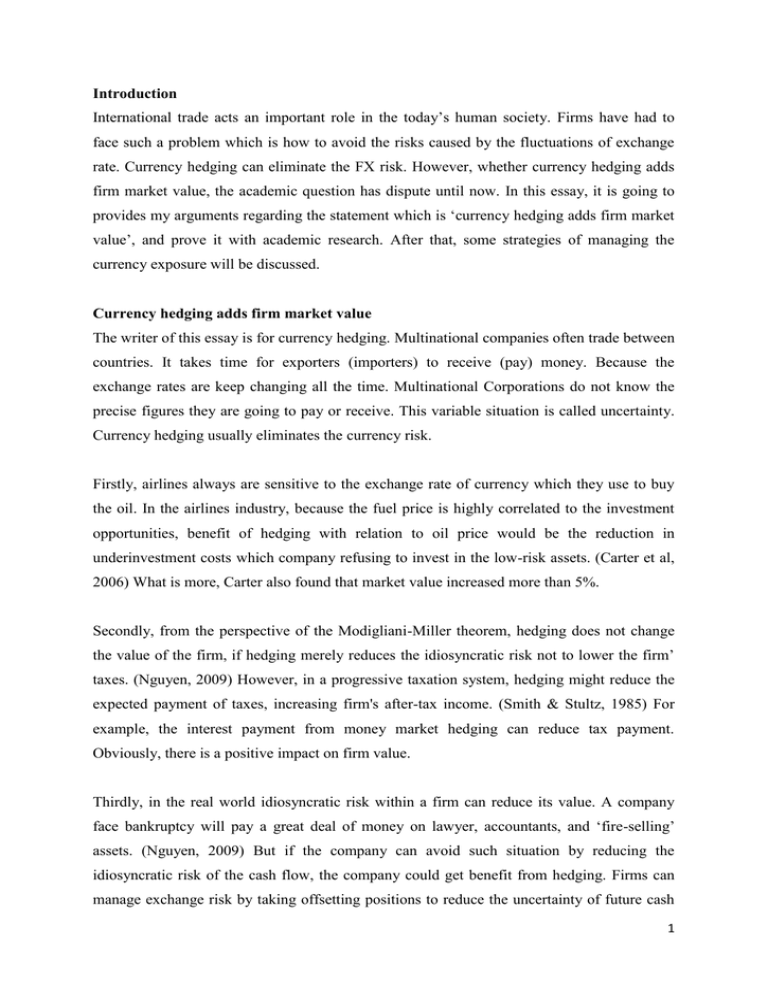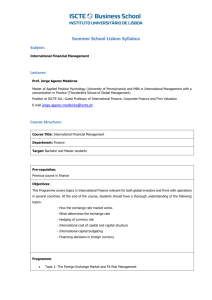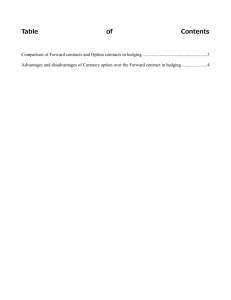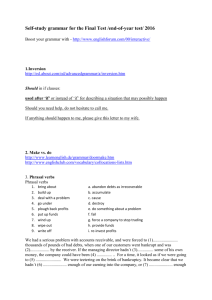Introduction International trade acts an important role in the today's
advertisement

Introduction International trade acts an important role in the today’s human society. Firms have had to face such a problem which is how to avoid the risks caused by the fluctuations of exchange rate. Currency hedging can eliminate the FX risk. However, whether currency hedging adds firm market value, the academic question has dispute until now. In this essay, it is going to provides my arguments regarding the statement which is ‘currency hedging adds firm market value’, and prove it with academic research. After that, some strategies of managing the currency exposure will be discussed. Currency hedging adds firm market value The writer of this essay is for currency hedging. Multinational companies often trade between countries. It takes time for exporters (importers) to receive (pay) money. Because the exchange rates are keep changing all the time. Multinational Corporations do not know the precise figures they are going to pay or receive. This variable situation is called uncertainty. Currency hedging usually eliminates the currency risk. Firstly, airlines always are sensitive to the exchange rate of currency which they use to buy the oil. In the airlines industry, because the fuel price is highly correlated to the investment opportunities, benefit of hedging with relation to oil price would be the reduction in underinvestment costs which company refusing to invest in the low-risk assets. (Carter et al, 2006) What is more, Carter also found that market value increased more than 5%. Secondly, from the perspective of the Modigliani-Miller theorem, hedging does not change the value of the firm, if hedging merely reduces the idiosyncratic risk not to lower the firm’ taxes. (Nguyen, 2009) However, in a progressive taxation system, hedging might reduce the expected payment of taxes, increasing firm's after-tax income. (Smith & Stultz, 1985) For example, the interest payment from money market hedging can reduce tax payment. Obviously, there is a positive impact on firm value. Thirdly, in the real world idiosyncratic risk within a firm can reduce its value. A company face bankruptcy will pay a great deal of money on lawyer, accountants, and ‘fire-selling’ assets. (Nguyen, 2009) But if the company can avoid such situation by reducing the idiosyncratic risk of the cash flow, the company could get benefit from hedging. Firms can manage exchange risk by taking offsetting positions to reduce the uncertainty of future cash 1 flows. From the perspective of accounting, a stable cash flow is the most important thing to the company, because it is about surviving. The more stable the cash flow the company has, the longer period of time the company might exist. Smith and Stultz (1985) showed that there may be some benefits for the companies by reducing the volatility of their cash flow, the existence of costs of financial distress which is bankruptcy costs. Hedging would reduce the likelihood of paying these costs, which would add value to the firm. In January 2000, Air Products faced a strong fluctuation in the USD/GBP exchange rate in previous months. ‘We still fell we did the right thing in hedging the transaction. When you do M&A you worry about having the economics of a deal change because of currency movements, and we are not in the business of making currency bets.’ says Paul Huck, Chief financial officer of Air Products. (Arnold, 2008) People might think that a firm without international operation does not add value from currency hedging. Cheng (2007) found there is a small and statistically insignificant hedging premium for companies no foreign involved. Even if GM only sells cars in US, it is still influenced by FX rate between JPY and USD. When JPY depreciates, Japanese car manufactories can get more market share with lower price. GM losses the market and the share price will go down. If shareholders invest in both Japanese car manufactures and GM, the fall in GM share price will be offset by the gain from Japanese car manufactures’ share price. The idiosyncratic risk can be eliminated by using the portfolio diversification. (Nguyen, 2009) In summary, currency hedging both adds international operation companies and noninternational operation companies’ market value more or less. Strategies of managing the currency exposure Generally, accounting exposure can be accepted if it has no impact on firm economic value. Multinational corporations use to hedge on the transaction exposure and operating exposure. On one hand, transaction exposure can be hedged with traditional risk management products and financial derivatives. On the other hand, operating exposure can be hedging with strategic and capital structure methods. Forwards 2 Multinational corporations can use foreign exchange forwards as a strategy to hedge currency exposure. Company will sell (buy) foreign currency in the future. The forward rate is ‘locked in’ at the currency date, in another word; the FX risk is eliminated by hedging with forwards. (Nguyen, 2009) (Figure 1) For example, a Chinese company needs to pay $100 million for equipments which are imported from USA in 6-month. The currency spot rate is Yuan 7.0/$. The Chinese company afraid the USD will appreciate to against Yuan. Chinese company buys USD forward from the Citibank at a forward rate of Yuan 7.1/$. In 6-month, if the future spot rate is Yuan7.4/$. The Chinese company will pay Yuan 740,000,000. However, the Chinese will not lose too much because the exchange rate is fixed at yuan7.1/$. The benefit from the hedging with forwards is Yuan740,000,000-Yuan 710,000,000=Yuan30,000,000 Money market hedging For example, an American firm is going to receive 7 million Yuan from Shanghai Zhenhua Port Machinery (SZPM) in 6 months. As a kind of strategy to hedge currency exposure, money market hedging involves borrowing in the money market. The amount borrowed, plus the interest, will be equal to the amount to be received from the importer (suppose Yuan 7m, Interest rate 4%)(Arnold, 2008). And then convert the borrowed Yuan to USD on the spot market (suppose spot Yuan 7/$). After that, invest the USD (suppose the interest rate of USD is 3%). If the future spot rate (6 months later) is Yuan7.5/$, the hedging is successful. (Figure 2) Yuan? =Yuan7m/(1+0.04/2)=6862745 Yuan 6862745/7=$980392 $980392*(1+0.03/2)=$995098 Yuan7m/7.5=$933333 (if not hedge) The exporter has removes FX risk of the deprecation of Yuan, because it holds cash in USD. $995098 is less than $1m originally anticipated. However, it is received months earlier and can earn interest. (Arnold, 2008) If the American firm did not choose hedging, there will be a great loss. If the company wishes to ‘play it safe’, money market is a good choice, because it yields the highest money value and is certain. Money market hedging usually fits the company is willing to take rational risk and has a directional view that Yuan maybe depreciating versus the USD. However, money market hedging may cause the company exposed to another risk. Suppose the exporter does not receive payment timely or some of its goods are rejected, the exporter will not have sufficient currency to perform forward contracts. 3 Netting & Matching Netting is where the subsidiaries settle intra-organisational currency debts for the net amount owed in a currency rather than the gross amount.(Arnold, 2008) If a parent company sold $1.5m of goods to subsidiary company on credit and the subsidiary sold 1m USD of goods to the parent company on credit. The net payment is $0.5m, thus the multinational company only take currency exposure on the difference between the debts. (Figure 3) Netting only applies to transfers within a group of companies. Matching can be used for intra-group transaction and those involving third parties. When companies use netting and matching, they have to find a target company with a close amount of debt. Because of the closer the amounts of debts are, the less currency exposure exists after netting or matching. Operating hedging Operating hedging is more complex and higher cost than transaction hedging. Because operating exposure is long-term and often difficult to identify accurately. In 1995, the US signed the ‘Plaza Agreement’ with Japan to promote appreciation of the JPY. The JPY appreciated again from 1990, Japanese export had a significant reduction in final consumer goods. The appreciation of the Yen caused a substantial increase in overseas investment. Japanese car manufacturers established car factories in US to have same currency movement of revenues and costs in tandem. This achieves the purpose of using USD as cost which can be offset by the revenue in USD terms. This strategy not only eliminated the currency risk but also eliminated possible trading barriers. Until 1995, the cars which Japanese car manufacturers made in US took 20.7% market share of US, while in 1985 this figure was only 2.0 %.( Office for Japanese Business, 2006) (Figure 4) Conclusion In conclusion, it is possible to improve the company’s market value when hedging reduced the tax or underinvestment costs of the company. Especially, when currency hedging reduces the likelihood of paying distress costs, firm market value adds. There are other strategies which can be used to hedging such as currency option, leading and lagging. The problem about how to select the appropriate strategy to manage risk depends on the level of awareness 4 of the company. A rational strategy is according to the company’s market share, company’s structure, cash flow and the degree of specialization on foreign exchange market. In my opinion, there is no universal strategy, only the strategy which is most suited to the realities of the company. 5 Reference Arnold,G. (2008) Corporate Finance Management, 4th edition, Harlow: FT Prentice Hall. pp.973-975,980 Carter, D.A., Rogers, D.A., Simkins, B.J., 2006. Does hedging affect firm value? Evidence from the US airline industry. Financial Management 35 Cheng,Q. (2007). Exchange rate exposure, corporate hedging and firm market value, City University of Hongkong Nguyen,M. (2009) Lecture on International Finance, Forward Markets, third year undergraduate course 2009/10, University of Bradford, School of Management, 10/11/2009 Nguyen,M. (2009) Lecture on International Finance, Managing Corporate foreign exchange risk module, third year undergraduate course 2009/10, University of Bradford, School of Management, 10/11/2009 Office for Japanese Business (2006). Currency hedging strategy of Japanese firms. http://www.10588.com/waimao/sw/sw/4888.shtml [Accessed 07/11/2009] Smith, C.W., Stulz, R.M., 1985. The determinants of firms' hedging policies. Journal of Financial and Quantitative Analysis 20, 391-405 6 Appendix Figure 1: Figure 2: 7 Figure 3: Figure 4: 8




